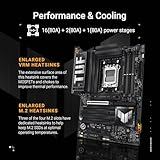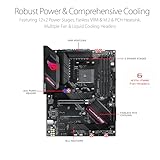 Advertising Disclosure
Advertising DisclosureMotherboards Comparison - April 2025

Our Top 3 Picks
Here are the top 3 recommended products with more information to help you find the right product for you9.8
1ASUS16% OffASUS TUF Gaming X870-PLUS WiFi AMD AM5 X870 ATX Motherboard, 16+2+1, 80A SPS Power Stages, DDR5, PCIe 5.0 Ready, Four M.2 Slots, Wi-Fi 7, 2.5Gb LAN, HDMI, USB4® 40Gbps, SATA 6 Gbps, USB 20Gbps Type-C
Why we love it
Supports future AI applications.
Ideal for gaming enthusiasts.
Stable and reliable performance.
Main highlights- Ready for Advanced AI PC: Designed for the future of AI computing, with the power and connectivity needed for demanding AI applications
- Overclocking Technologies: Dynamic OC Switcher, Core Flex and PBO Enhancement
- Intelligent Control: ASUS-exclusive AI Overclocking, AI Cooling II, and AEMP to simplify setup and improve performance
- Enhanced Power Solution: 16+2+1, 80A SPS power stages, 8-layer PCB, ProCool connectors, alloy chokes and durable capacitors for stable power delivery
- AMD AM5 Socket: Ready for AMD Socket AM5 for AMD Ryzen 9000 & 8000 & 7000 Series Desktop Processors
9.5
2ASUS21% OffAsus ROG Strix B550-F Gaming WiFi II AMD AM4 (3rd Gen Ryzen) ATX Motherboard (PCIe 4.0,WiFi 6E, 2.5Gb LAN, BIOS Flashback, HDMI 2.1, Addressable Gen 2 RGB Header and Aura Sync)
Why we love it
Supports latest AMD Ryzen processors.
Features WiFi 6E for fast connectivity.
Robust power solution ensures stability.
Main highlights- Smooth networking: On-board WiFi 6E (802.11ax) and Intel 2.5 Gb Ethernet with ASUS LANGuard
- Robust power solution: 12+2 teamed power stages with ProCool power connector, high-quality alloy chokes and durable capacitors
- Renowned software: Bundled 60 days AIDA64 Extreme subscription and intuitive UEFI BIOS dashboard
- Best gaming connectivity: PCIe 4.0-ready, dual M.2 slots, USB 3.2 Gen 2 Type-C, plus HDMI 2.1 and DisplayPort 1.2 output
- AM4 socket: Ready for AMD Ryzen 3000 and 5000 series, plus 5000 and 4000 G-series desktop processors.Bluetooth v5.2
9.4
3ASUS20% OffASUS TUF Gaming Z790-Plus WiFi LGA 1700(Intel 14th,12th &13th Gen) ATX Gaming Motherboard(PCIe 5.0,DDR5,4xM.2 Slots,16+1 DrMOS,WiFi 6,2.5Gb LAN,Front USB 3.2 Gen 2 Type-C,Thunderbolt 4(USB4),Aura RGB)
Why we love it
Easy installation and setup process.
Versatile for gaming and productivity.
Excellent cooling for M.2 SSDs.
Main highlights- Ultra-Fast Gaming Networking : WiFi 6 AX201 (802.11 ax), Intel I225-V 2.5Gb LAN, TUF LANGuard and TurboLAN technology
- PC DIY Friendly: SafeDIMM, PCIe 5.0 Safeslot, Q-LED, M.2 Q-Latch, Pre-mount I/O shield
- New TUF Gaming Aesthetics: New ID design, Synchronizable LED effects across a vast portfolio of compatible PC gear, including addressable RGB strips with Aura Sync
- Intel LGA 1700 socket: Ready for 12thand13th Gen Intel Core processors, support PCIe 5.0,DDR5 and out of box Windows 11 ready
- Immersive Gaming Audio and AI Noise Cancellation: The Realtek S1200A codec offers pristine audio quality to draw you deeper into the game action or to enhance your favorite music tracks or videos.Communicate clearly with ASUS AI Noise Canceling Mic technology
- Fastest Connectivity: 4x M.2/NVMe SSD, Front panel USB 3.2 Gen 2 Type-C header, USB Gen 2x2 Type-C and Thunderbolt 4 (USB4)header
- Enhanced Power Solution: 16plus1 DrMOS, ProCool sockets, military-grade TUF components, and Digiplus VRM for maximum durability and performance
- Comprehensive Cooling : VRM heatsink, PCH fanless heatsink, M.2 heatsink, hybrid fan headers and Fan Xpert 4 utility

Motherboards Buyer's Guide
 Written by Jim Williams
Written by Jim WilliamsIntroduction
Motherboards are the backbone of any computer system and are a vital component to consider when building a PC. There are many different types of motherboards available on the market, each with their own specific features and capabilities. It is important to consider the form factor, chipset, socket type, memory, expansion slots, and other features when selecting the motherboard that is best suited for your needs. There are many different brands and models available, so it is important to do your research before making your purchase.
Form Factor
The form factor of a motherboard is an important factor to consider when selecting a motherboard for your system. The form factor determines the size of the motherboard, as well as the placement of certain ports and components. The most common form factors are ATX, Micro ATX, and Mini ITX. ATX is the most common form factor, and motherboards in this form factor are typically larger, offering more features and expansion slots. Micro ATX and Mini ITX motherboards are smaller in size, offering fewer features and expansion slots, but they can still be powerful enough for many systems.
Chipsets
The chipset is a key component of the motherboard and determines the processor compatibility and the features that are available. Different chipsets offer different features and capabilities, so it is important to select the chipset that is best suited for your needs. Intel and AMD both offer a variety of chipsets, ranging from entry-level to high-end. It is important to research the available chipsets to make sure you select the one that is best suited for your needs.

Socket Type
The socket type of the motherboard is important to consider when selecting a motherboard for your system. The socket type determines the type of processor that is compatible with the motherboard. Intel and AMD both offer a variety of socket types, so it is important to select the one that is compatible with your processor. It is important to select the correct socket type to ensure compatibility and to ensure that you can upgrade to a more powerful processor in the future.
Memory
The memory of a motherboard is an important factor to consider when selecting a motherboard for your system. Different motherboards offer different memory configurations, so it is important to select the one that is best suited for your needs. Memory speeds and capacities vary, so it is important to research the available memory configurations to make sure you select the one that is best suited for your needs.
Expansion Slots
Expansion slots are a key feature of any motherboard and offer the ability to add more components and peripherals to a system. Different motherboards offer different expansion slots, so it is important to select the one that is best suited for your needs. Common expansion slots include PCI, PCIe, and AGP. It is important to research the available expansion slots to make sure you select the one that is best suited for your needs.

Our ranking system
At BestChoice.com, our team curates a selection of top products from a vast array available online, using a sophisticated ranking system based on carefully defined criteria.While traditional hands-on testing has its merits, our use of AI technology offers distinct advantages. AI allows us to process and analyze vast amounts of data from multiple sources, providing a comprehensive view that goes beyond what manual testing can achieve. This approach enables us to deliver insights that are aligned with current trends and consumer preferences, ensuring our reviews are both relevant and up-to-date.
Features
Our AI-driven analysis examines key attributes, capabilities, and other critical factors tailored to each product category. This method allows us to assess effectiveness from various perspectives, ensuring a well-rounded evaluation.
Consumer Reviews
We aggregate and evaluate consumer feedback from across the internet, giving weight to ratings and reviews that reflect the most reliable insights. AI enhances this process by filtering and prioritizing data, offering a balanced view without the need for direct personal endorsements.
Popularity
Our system also considers the popularity of products, analyzing factors such as market presence, reputation, and user satisfaction. By leveraging AI, we capture a comprehensive picture of a product's standing in the market, which may not always be evident through traditional testing.
Value for money
AI allows us to compare products based on attributes like price, specifications, and user feedback, helping to determine their value for money. This data-driven approach offers an efficient and reliable way to assess how products stack up against one another in terms of cost-effectiveness.




































